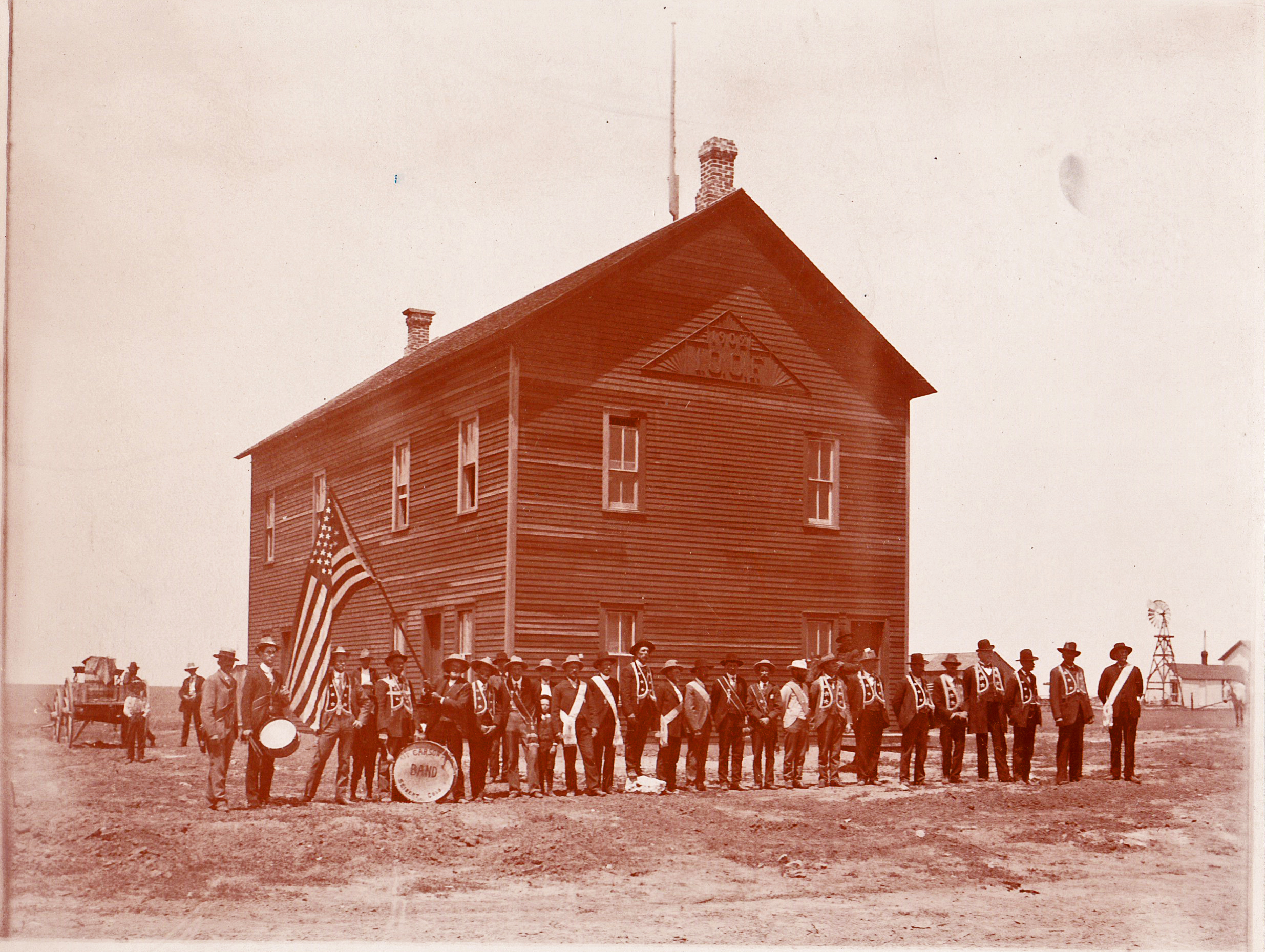This cabinet photo depicts a long row of men adorned in sashes and stars, lined up in front of a large two-story IOOF (International Order of Odd Fellow) lodge built in 1909 in Seibert, Colorado. Perhaps they were IOOF members. As far as musical instruments go, I see a bass drum and a snare drum. Perhaps the other band members played the small kazoo, which is easily palmed or pocketed.
I wish I knew more about this picture. I did a Google search, and there is no longer an IOOF Lodge in Seibert. I found nothing about J.F. Carson or the J.F. Carson band.
Seibert, which is located in Kit Carson County, was named for Henry Seibert, a Rock Island Railroad official and New York millionaire, who donated a 500-book library to the town. The town was platted in 1888 and incorporated in 1917. It’s about 57 miles west of the Colorado/Kansas border, and is one of a chain of towns stretching east from Limon on I-70. There’s Genoa, Arriba, Flagler, Seibert, Vona, Stratton, Bethune and Burlington.
Seibert is now a very small town – its estimated population in 2018 was 216, but in years past it was a vibrant community. A 1903 article appearing in “The Weekly Gazette,” a Colorado Springs newspaper, reported that “Next to Burlington (the county seat), Seibert is the most important town in the county.” At that time, Seibert was doing “an immense amount of business” as a supply point for sheep and cattle ranches “for miles around,” and boasted two general stores, a drug store, two restaurants, a lumber yard and “a graded school with an enrollment of 24 scholars.” It was home to a circuit preacher, the Revered W.W. Hawkins, who held services at Seibert, Cope (which is about 25 miles due north of Seibert), and Claremont (possibly an old name for Stratton.) Later, Seibert had its own railway depot and newspaper, the “Seibert Settler,” and by 1922, the high school had its own building.
I read in the above article that a Dr. A.M. Blumberg of Denver had just opened an office in Seibert, and that the Seibert residents were “quite anxious to have him stay,” as the town had been without a doctor for some time. I can’t imagine what it must have been like at that time for parents needing medical treatment for a seriously ill or injured child, knowing they might have to ride miles to reach a doctor.
Evidence of the importance of cattle ranching in the Seibert area and eastern Colorado as a whole can be found in issues of the Range Ledger newspaper published in Hugo, CO (Hugo is about 15 miles southeast of Limon). The “Ledger,” which described itself as “Devoted to the Livestock Interests of Eastern Colorado” included in its issues a section which had the appearance of classified ads, but each of the boxes filling this section contained a rancher’s name, the town closest to the ranch, an illustration of the rancher’s brand, a description of the placement of the brand and the geographic location(s) in which the rancher grazed his livestock. For example, in the January 2, 1902, issue of the “Ledger,” J. A. Van Deventer of Seibert lists his brand as “JAV,” which could be found on the left side of his cattle and the left shoulder of his horses, along with an “ear mark” hole in the left ear. Van Deventer grazed his cattle “between Republican and Hell Creek.”
That eastern Colorado has an abundance of wind is attested to by the presence in 1903 of a planing mill in Burlington (which is about 32 miles east of Seibert), owned by O.D. Rogers, which was run by a 14-foot windmill.
REFERENCES:
- “In Eastern Colorado,” appearing in The Weekly Gazette (Colorado Springs) February 26, 1903 (www.newspapers.com )
- Google Maps
- Range Ledger, Dated January 2, 1902 (www.coloradohistoricnewspapers.org)
- Range Ledger, Dated April 26, 1919 (www.coloradohistoricnewspapers.org )
- “Seibert, Colorado,” Wikipedi.org at https://en.wikipedia.org/wiki/Seibert,_Colorado
- Steamboat Pilot, March 5, 1953 (www.coloradohistoricnewspapers.org )

